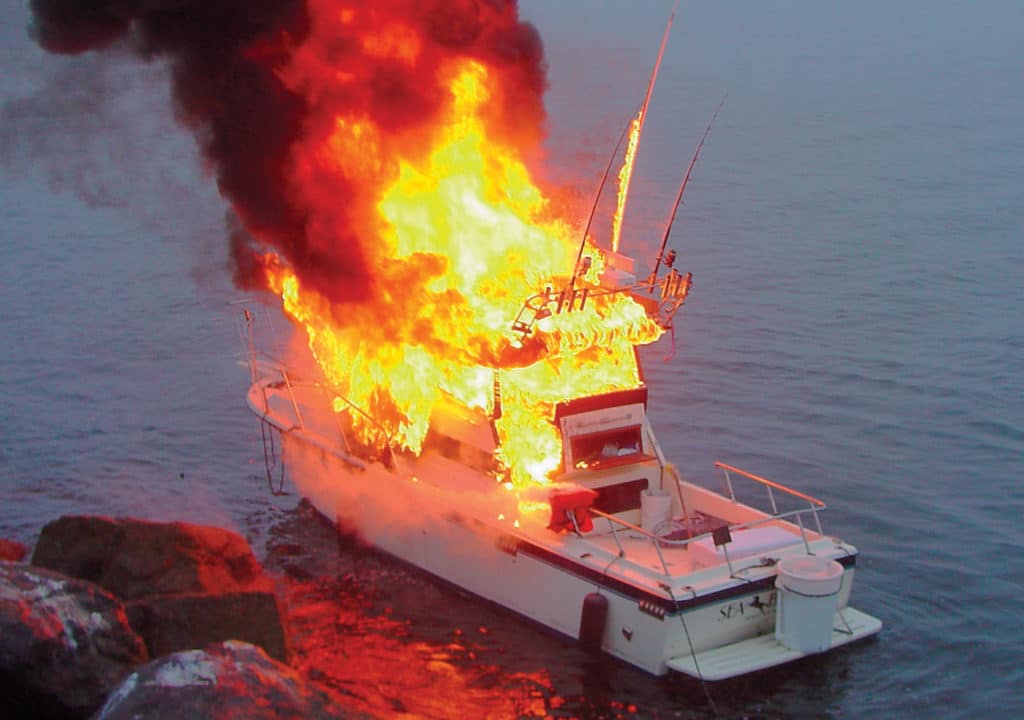
I’ve always been amazed that, in most cases, boat fires quickly become catastrophic. Amazed because … look at all the water boats float upon! Perhaps these fires quickly turn into unstoppable blazes because the materials involved (for example, in the case of fuel or electrical fires) cannot be extinguished with water? While we certainly subscribe to an ounce of prevention being worth a pound of cure, if your boat catches fire, you and your crew had better be prepared with a ton of cure and know how to use it!
PREVENTION
Obviously, take great care when fueling your boat — whether you have outboards or inboards. Certainly gas inboards have a greater chance of leaking gasoline into the bilge since all the fuel lines run inside your hull. But outboard vessels also have fuel tanks that might leak and fuel lines running from the tank out the transom and into the engines. Anytime you carry combustibles aboard a boat, you risk fire.
Before you leave the dock, stick your nose down into the bilges and take a big sniff. If you drive a gas inboard boat, close all hatches while fueling; then, open them all and run your blower for a few minutes prior to turning the key.
Occasionally check the fuel-line fittings as well as all your electrical connections for fraying, chafing or corrosion. Replace as needed.
If your boat has portable fuel tanks, leave the vent open while under way. Then, close it when you stop.
Be sure heating and cooking appliances access power properly and have the proper-sized breakers or fuses in the line.
Make sure all your Coast Guard-approved fire extinguishers are up to date, full and easily accessible. Buy a few extra inexpensive extinguishers and learn how to use them properly. Practice now may save your life later.
Never store oily or fuel-laden paper towels or rags aboard.
PREPARATION
When was the last time you instructed your crew or guests on emergency procedures before leaving the dock? That long, eh? It’s actually something you should make a habit of each time you venture forth. Practice fire drills, man-overboard and emergency communications drills for everyone. Let them know where the fire extinguishers, flares, life vests and life raft are located. Explain how each is used. If Murphy enters your life, stacking the odds against him can’t hurt. Plus, perhaps it’s like bringing your foul-weather gear to prevent rain.
Make sure that your digital selective calling (DSC) VHF has been programmed with the proper information. Also be sure that you’ve registered it and received your MMSI number. Now, explain to all aboard how to use the radio correctly in case of emergency. In most cases, it will mean naught more than pressing the red button.
POUND OF CURE
Undoubtedly, you already instructed each crewmember as to their responsibilities in the event of fire. One person gets the life raft ready to deploy and stands by it. Another makes the Mayday call on the radio. You grab the proper fire extinguisher and P.A.S.S. That stands for: P: Pull the pin. A: Aim extinguisher nozzle at the base of the flames. S: Squeeze the trigger while holding the extinguisher upright. S: Sweep the extinguisher from side to side.
Fire out? Great! No? Abandon ship into your life raft. The boat can be replaced. Of course, this all assumes that you’re in a relatively open boat. If you have an enclosed engine room, your vessel should be equipped with a built-in fire-suppression system. Many older boats have a system that uses a gas called halon. Newer vessels have other systems since halon was banned as ozone-depleting in 2000.
I am told that burns constitute the most painful injuries you can ever encounter. Always leave yourself and your crew a clear path of escape.
The U.S. Coast Guard is asking all boat owners and operators to help reduce fatalities, injuries, property damage, and associated healthcare costs related to recreational boating accidents by taking personal responsibility for their own safety and the safety of their passengers. Essential steps include: wearing a life jacket at all times and requiring passengers to do the same; never boating under the influence (BUI); successfully completing a boating safety course; and getting a Vessel Safety Check (VSC) annually from local U.S. Coast Guard Auxiliary, United States Power Squadrons(r), or your state boating agency’s Vessel Examiners. The U.S. Coast Guard reminds all boaters to “Boat Responsibly!” For more tips on boating safety, visit www.uscgboating.org.








